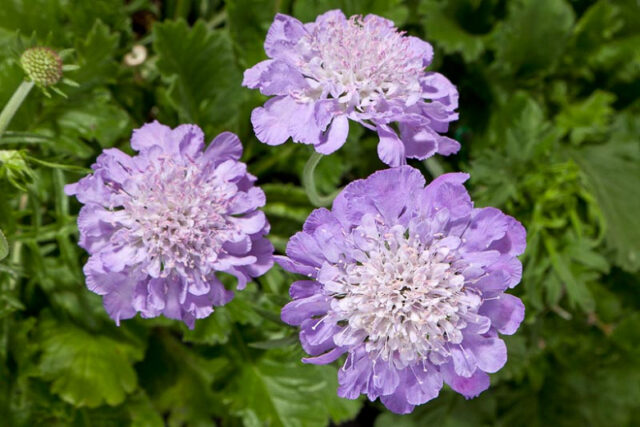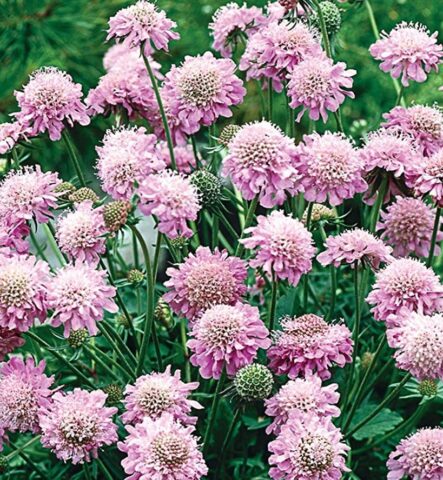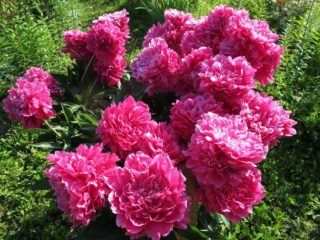Content
Scabiosa is a perennial herbaceous plant that has about 100 species. Quite a few varieties are grown in culture, many of them are adapted to the climatic conditions of Russia. Scabiosa is unpretentious, it thrives in the sun and partial shade, and blooms even on depleted soils. Therefore, both experienced and novice gardeners can cope with cultivation.
Description and photo of scabiosa
Scabiosa is a herbaceous perennial belonging to the teasel family. The plant is distributed in different areas - from the temperate climate of Eurasia to the mountains of Eastern and Southern Africa. The name is related to the Latin word “scabies”, which translates as “rough”. This is due to the characteristic surface of the foliage. According to another version, different peoples used the leaves of this perennial plant to treat scabies.
The stems of the grass are erect, quite strong, the height of the scabiosis, depending on the type and variety, ranges from 10 to 100 cm. The leaves are located opposite each other. They are solid, pinnately dissected or separate.
Scabiosa perennial flowers are collected in capitate inflorescences of spherical or flattened shape. They are quite dense, growing on long peduncles with bracted leaves. The corollas are funnel-shaped, consisting of five petals that grow together. The color of scabiosa is varied: blue-violet, blue, pure white, crimson, burgundy, red.
Perennial scabiosa blooms mainly in the second half of summer and early autumn. Specific terms and duration depend on the characteristics of the variety and type. The fruit is formed in the first half of autumn. It is an achene with small, light brown, oval-shaped seeds.
Types and varieties of scabiosa
About 100 species of perennial scabiosa are known. Based on some, varieties have been developed that are grown in cultivation. The following varieties are common in Russia:
- Pigeon (Scabiosa columbaria) - found mainly in the southern regions of Russia: Crimea, North Caucasus. Grows in meadows, shores of water bodies, and on moist soils. Biennial, height up to 100 cm, stems erect, partially pubescent, branching in the upper part. The inflorescences are red-violet, the leaves are pinnately divided. Flowering continues from mid-July to the last ten days of September.
- Starfish (Scabiosa stellata) is native to Southern Europe. Annual, low stems, no more than 45 cm. The leaves are located opposite each other, whole below, with jagged edges. The color of the flowers is pale blue, the inflorescences are capitate, the shape is spherical.Peduncles are long and strong.
- Caucasian (Scabiosa caucasica) is mainly found in the North Caucasus. A perennial flower, in many regions it is grown as an annual (through seedlings). It usually reaches a height of 70-80 cm. The stems are erect and strong, the leaves are lanceolate, narrow, with a bluish tint. The flowers are small, varied in color - blue, pure white, dark purple, pink. Inflorescences reach 10 cm in diameter.
- Dark purple (Scabiosa atropurpurea) – annual or biennial. The stems branch well, are straight and strong, reach a height of 30 to 100 cm, and have pubescence. Color green. The flowers are small, the color can be different - from pure white and pinkish to bluish, dark purple. They are located in single capitate inflorescences, reaching a diameter of 6-7 cm.
Planting scabiosa seeds in open ground
Perennial scabiosa can be propagated by dividing the bush or grown from seeds. There are two ways to plant them:
- Direct sowing into the ground.
- For seedlings with growing seedlings at home.
Landing dates
The timing of planting seeds of perennial scabiosis depends on the growing method:
- If seedlings are needed, work begins at the end of February or early March.
- If you plan to plant in open ground, you can start it in May.
It is worth considering that seedlings must grow in warm weather, without returning frosts. If May is forecast to be cold, the dates can be postponed by 1-2 weeks. In Siberia, sowing sometimes begins as early as early June.
In what soil should scabiosa be planted?
Scabiosa is a perennial unpretentious plant; it grows in a variety of soils, including depleted ones. But for more lush and long-lasting flowering, it is better to plant on loose, fertile soils, optimally loamy.If the soil is too dense, sawdust or sand is added to it; you can also add compost or humus.
The planting site should be sunny, although perennial scabiosa can easily withstand partial shade. The main requirement is that the site should not be flooded by rainwater, since the roots of the plant cannot withstand prolonged exposure to wet conditions.
Sowing technology
The algorithm for sowing seeds of perennial scabiosis is as follows:
- It is necessary to clean the flowerbed and carefully level the surface.
- Prepare holes 3-5 cm deep at a distance of 40 cm.
- Plant the seeds and sprinkle with soil without compacting it.
- Then water every day until shoots appear.
- If at night the temperature drops below 10 degrees Celsius, cover with film.
- After the emergence of seedlings, it is enough to water twice a week.
When and how to plant scabiosa seedlings
Perennial scabiosa seeds begin to be planted for seedlings at the end of February. To do this, prepare fertile, loose soil in advance, for example, based on garden soil with humus, peat and sand in a ratio of 2:1:1:1.

Seeds of perennial scabiosa are planted in open ground in mid-May.
Rules for growing seedlings:
- Plant the seed at a shallow depth of 2-3 cm, leaving 5-7 cm between the furrows.
- Sprinkle with soil.
- Moisten with a spray bottle.
- Cover with film and place on the windowsill. Grow at room temperature.
- After the appearance of two leaves, seedlings of perennial scabiosa seedlings dive into different containers.
- Two weeks before transplantation, they begin to harden.
- In the middle or second half of May, the seedlings are transferred to open ground.
- Water generously so that the roots take root in the new location as quickly as possible.
Care for scabiosa in open ground
To grow a beautiful scabiosa flower, as in the photo and description, you must follow the basic rules of care. The plant needs watering and periodic fertilizing. You should also prune and take care of preparing for winter, especially in regions with frosty climates.
Watering
Perennial scabiosa does not need heavy watering. If it rains periodically, additional moisture is not needed. If they are not there, the heat has set in, water is given weekly, and in hot weather - twice a week. The liquid should be warm and settled.
Top dressing
The scabiosa plant (pictured) can bloom beautifully and for a long time. To do this, you should periodically fertilize.

It is best to use mineral mixtures as fertilizers for scabiosis.
They are given in April, then during the formation of buds and during the flowering period once every 2-3 weeks. In this case, organic matter can only be used during planting or when preparing the soil. The rest of the time, it is not recommended to use it, since the crop does not tolerate mullein and droppings well.
Loosening the soil
When growing scabiosa flowers, care should also be taken to loosen the soil. The surface layer needs to be dug up with a hand rake or a small spatula to a depth of 3-4 cm. It is better to do this after heavy rains or waterings. Thanks to this, the soil does not have time to become too compacted and remains quite loose. Therefore, the roots gain access to oxygen, and the flower grows better.
To ensure that they grow as little as possible, it is advisable to mulch the soil around perennial scabiosa with sawdust, straw, grass clippings or other materials.

In order for the crop to bloom well, you need to periodically loosen the soil.
Trimming
It is enough to prune perennial scabiosa only in the second half of autumn. Shortly before frost, the entire above-ground part should be removed, cutting it flush with the ground and leaving stumps 2-3 cm high. It is advisable to treat the sections with charcoal powder or a weak solution of potassium permanganate, a fungicide.
As the flower stalks wither, they need to be cut off, preventing seeds from forming. Scabiosa is a perennial prolific plant. It can spread by self-seeding, occupying significant space and displacing other plants.
Wintering
Perennial scabiosa needs to be prepared for wintering only in regions with harsh winters. It is necessary to cover it with dry mulch - straw, sawdust, pine needles. The height of the layer should be at least 10 cm. In early spring, the protective layer is removed so that the plant does not rot. In the south there is no need to cover scabiosa. She will survive the winter in the open ground normally.
Protection from pests and diseases
To grow a beautiful scabiosis flower, it is important to take into account not only the rules of planting and care, but also take care of the prevention of diseases and pests. If you regularly violate the watering norm, the plant may suffer from powdery mildew or root rot. For prevention and treatment, fungicides are used, for example, “Topaz”, “Previkur”, “Fundazol”, “Maxim”, “Gamair” and others.
Of the pests for perennial flowers, moth larvae are especially dangerous. For control, insecticides are used: “Karbofos”, “Akarin”, “Bitoxibacillin”, “Fitoverm”.
Plants can also be damaged by voles. For prevention, it is necessary to install traps or use special poisons.
Seed collection
Since the seeds of perennial scabiosa are quite light and are carried by the wind, you need to put a gauze bag over the ripening inflorescences. As soon as the seeds become a rich burgundy color, they can be collected and dried. Then put it in a box or bag made of natural fabric. Keep refrigerated.
Subject to storage conditions, the seeds remain viable for four years. They can be sown in open ground or used to grow seedlings.
Scabiosa in landscape design
Perennial scabiosa looks beautiful in single plantings and compositions. It is used in various flower beds, planted along borders and paths, and decorated with alpine slides. Below are several ways to place this interesting plant:
- Rocky hill.
- Single planting of perennial scabiosa
- Composition of different varieties.
- Another option for solitaire planting.
Conclusion
Perennial scabiosa perfectly decorates the garden thanks to its lush spherical inflorescences of different colors - white, pink, blue, purple. This is an unpretentious plant that can be grown as an annual and perennial. Responsive to stable watering and fertilization. Following simple care rules will ensure long flowering.
















